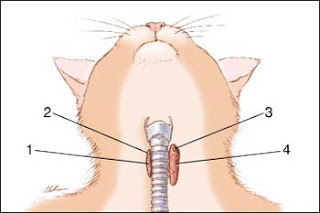Unlike dogs, cats have thyroid glands that become overactive. This is one of the top three diseases we see in older cats (generally those >7yrs old). The other two are diabetes mellitus and kidney disease.
The signs for all three of these diseases can be similar, so a baseline blood panel and urinalysis are the best way for your vet to sort it out. Don’t forget, they can have more than one thing going on at a time too, which may change the way we handle the treatment and follow-up care of your cat.
Signs include but are not limited to: weight loss despite a generally great (sometimes RAVENOUS) appetite, increased drinking/urination, hyperactivity, and behavioral changes (including aggression, vocalizations without cause, not using the litterbox). There are a very small percentage (5%) of cats that go the opposite way though. These cats become lethargic and don’t eat well.
 |
| Skinny cat with unkempt coat that is often seen in cats with thyroid disease. |
In most of these cases, on a physical exam of the cat we find the thryoid glands to be enlarged (in a normal cat, these are not normally something we can feel). Many times the cat also has a rapid heart rate (tachycardia).
 |
| 1. normal thyroid gland 2. and 3. parathyroid glands 4. enlarged thyroid gland |
The T4 IS generally a great way to determine if your cat has a thyroid problem. If this is normal but your vet really suspects hyperthyroidism, they may want to add the Free T4.
There are several treatments. The most common is to give a twice a day medication called methimazole. We can have a liquid compounded and flavored for your cat or you can give pills. This is a lifelong treatment. This drug works by blocking excess production of thyroid hormone and doesn't destroy any tissue, which is why it needs to be given regularly.
There are also trans-dermal formulations (goes through the skin). These do seem to work fairly well. They are also compounded for us by special pharmacies and are rubbed on the ears. This is sometimes used when a cat can't tolerate any oral formulations.
As with any animal on chronic medication, we will want to do a follow blood panel (checking those kidney values AND the thyroid level). After the cat's thyroid is in the normal range, rechecks can be done every 6 months to a year.
The other primary way to deal with it is to have your cat treated with I131(radioactive iodine). This is a one time treatment! Don’t worry, this is safe. It IS done at only certain facilities and your cat will stay a few short days. This is NOT done initially because sometimes cats that have hyperthyroidism have “hidden” kidney disease. The higher metabolism that hyperthyroidism produces results in more blood flow through the kidneys. When we correct this, sometimes we unmask this other disease process. So we always start with the first option - then we can back down if we need to.
This is a great way to go if your cat is younger when diagnosed and/or you have difficulty medicating twice a day for the remainder of the cat’s life. It is initially more expensive up front but if your cat is 10 when diagnosed and lives until she’s 20, it will be cheaper in the long run.
A good website that discusses this is: Radiocat. They do not have any locations in this part of PA or anywhere in NJ. For those living in the Lehigh Valley, there are places that do offer this: Valley Central Nuclear Medicine, Metropolitan Veterinary Associates and The University of Penn School of Veterinary Medicine.
I did not discuss surgery which has been used in the past to treat this disease, because it has generally fallen out of favor, especially since we have other great options.
If you cat shows ANY changes in her normal behaviors, no matter how subtle, please make an appointment with your veterinarian.


No comments:
Post a Comment